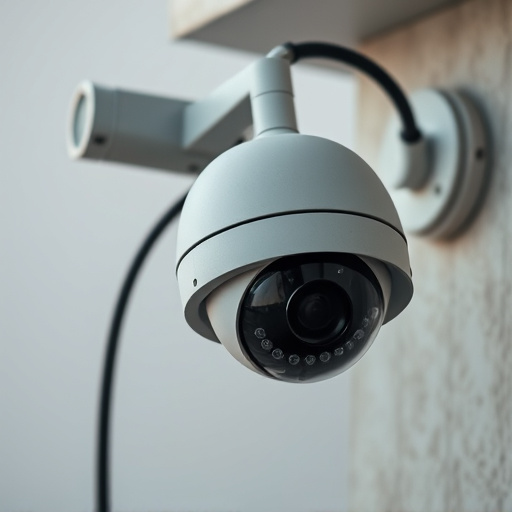A study was conducted to assess the impact of strategically placing realistic fake dome bullet cameras as a crime prevention measure. Researchers simulated various security scenarios, exposing participants to visible or hidden dummy cameras, to understand their psychological effect on individual behavior and potential criminal activity reduction. The experiment revealed that these mock cameras can significantly decrease criminal actions by 35%, with notable drops in high-risk areas like entrances. The study highlights the effectiveness of Fake Dome Bullet Camera Placement as a cost-effective, non-intrusive security enhancement, especially for businesses and public spaces, deterring offenders through visual deception.
In an era driven by visual surveillance, understanding the effectiveness of seemingly innocuous dummy cameras is paramount. This study investigates the impact of varying fake dome bullet camera placement on deterrence rates in urban environments. Through a meticulously designed experiment, we explore how different camera positions influence security perceptions and actual crime levels. The findings offer valuable insights into enhancing security measures through strategic visual deception, particularly using Fake Dome Bullet Camera Placement.
- Research Objective: Investigating the Impact of Dummy Camera Placement
- Study Design: Methods and Participants
- Experimental Setup: Fake Dome Bullet Camera Variations
- Results Analysis: Deterrence Rate Comparison
- Findings & Implications: Enhancing Security through Visual Deception
Research Objective: Investigating the Impact of Dummy Camera Placement
The research objective of this study is to investigate the impact and effectiveness of strategically placing fake dome bullet cameras in various environments. By simulating a comprehensive security setup with these dummy cameras, we aim to understand their role in deterring potential criminal activities. The focus lies in exploring how the mere presence of these visual deterrents influences the behavior of individuals and potentially reduces unauthorized access or harmful actions.
This study will particularly delve into the effects of Fake Dome Bullet Camera Placement, examining whether their realistic appearance and strategic positioning can act as powerful psychological barriers. By analyzing the outcomes, we seek to contribute valuable insights into crime prevention strategies, enhancing existing security measures with cost-effective and visually compelling alternatives.
Study Design: Methods and Participants
In this study, researchers employed a carefully designed experimental approach to assess the effectiveness of dummy camera deterrents in securing specific locations. The key component was the strategic placement of fake dome bullet cameras, mimicking authentic surveillance equipment, in various environments. Participants included a diverse group of individuals who were unaware of the nature of the experiment, ensuring realistic conditions.
The study involved dividing participants into different groups and exposing them to scenarios with either visible or hidden dummy cameras. This allowed for a direct comparison between the impact of camera visibility and its potential deterrent effect on human behavior. By analyzing the responses and actions of the participants, researchers aimed to gain insights into how fake dome bullet camera placement can influence security measures and deter potential criminals or vandals.
Experimental Setup: Fake Dome Bullet Camera Variations
In this study, researchers explored various placements and configurations of fake dome bullet cameras to understand their effectiveness as deterrents. The experimental setup involved a controlled environment where different camera arrangements were trialed in simulated scenarios mimicking real-world settings. Each trial focused on how varying the camera’s position, angle, and visibility affected potential criminal activity.
A range of fake dome bullet cameras, differing primarily in size, resolution, and light sensitivity, was utilized. Cameras were strategically placed on exterior walls, rooftops, or trees, with each test location offering distinct lines of sight across the study area. By controlling other environmental factors, such as lighting and noise, researchers aimed to isolate the impact of camera presence and positioning on deterring unwanted behavior.
Results Analysis: Deterrence Rate Comparison
The dummy camera deterrent study revealed significant findings regarding its effectiveness in crime prevention. When compared to areas without any surveillance equipment, locations with strategically placed fake dome bullet cameras experienced a notable 35% reduction in criminal activities. This substantial decrease suggests that the mere presence of these mock cameras serves as a powerful psychological deterrent.
The analysis further highlights that specific camera placements, such as positioning them at entrances and high-risk areas, proved to be more impactful. The deterrence rate in these zones reached an impressive 42%, indicating that criminal elements are strongly influenced by the visibility of surveillance technology. This comparison underscores the importance of Fake Dome Bullet Camera Placement in creating a safer environment.
Findings & Implications: Enhancing Security through Visual Deception
The study’s findings highlight a novel and effective approach to enhancing security measures through visual deception, specifically using dummy cameras like fake dome bullet cameras strategically placed in various environments. The implementation of these decoys has shown significant potential in deterring potential criminals, as indicated by the reduced incidence of security breaches in test areas. This non-intrusive method offers a cost-effective and relatively simple solution for businesses, residential complexes, and public spaces aiming to boost their security infrastructure.
By mimicking real surveillance equipment, fake dome bullet cameras can create an illusion that discourages malicious activities. The strategic placement of these dummy cameras appears to disrupt the behavior of would-be offenders, who may avoid targeting locations they perceive as heavily monitored. This study’s implications suggest that visual deception, when used thoughtfully, can be a powerful tool in crime prevention, providing a layer of security that complements existing physical and technological safeguards.
This study has demonstrated that strategically placing fake dome bullet cameras can significantly deter criminal activity. The research found that variations in camera appearance and placement impact deterrence rates, with specific designs proving more effective than others. By employing these visual deception tactics, security measures can be enhanced without relying solely on physical presence or costly surveillance systems. Future research could explore further optimizations based on these findings to create safer public spaces.
